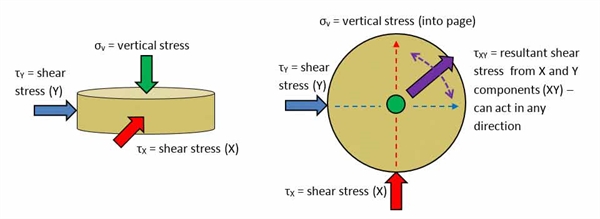What is a multi-directional laboratory test apparatus?
A significant majority of test apparatuses traditionally used in soil laboratories shear soil elements in a single direction only. Examples include the direct shear apparatus, in which a test specimen is sheared in a single horizontal direction following application of normal stress, and the triaxial apparatus, in which soil elements are compressed or extended vertically following completion of saturation and consolidation. Such apparatuses may be termed uni-directional, as the direction of shearing is fixed to one specific axis.
It is however possible to design and build more advanced apparatuses in which soil elements can be sheared in more than one direction – such apparatuses may therefore be termed multi-directional. To highlight this idea, Figure 1 displays a three-dimensional and plan view of a soil element subjected to vertical normal stress and shear stresses applied from two directions (τX and τY). Here the application of τy perpendicular to τX leads to resultant shear stress, τXY, acting in a direction different to the X and Y components. Further to this, changing the relative magnitudes of τX and τY vary the direction in which τXY acts, enabling shear in any horizontal direction to be specified and applied.

Download the full article here.